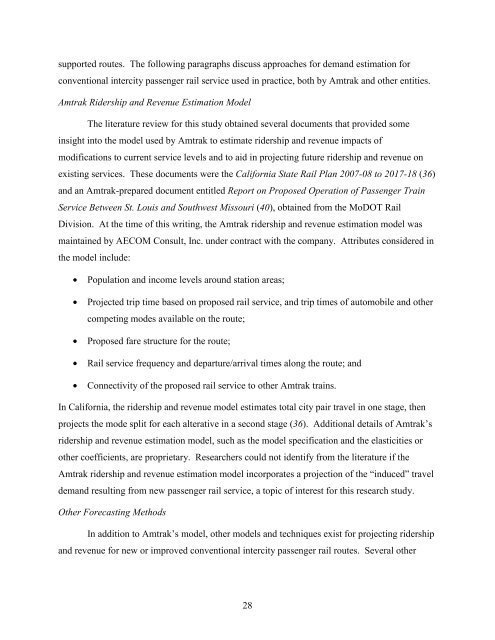Measuring the Benefits of Intercity Passenger Rail: A Study
Measuring the Benefits of Intercity Passenger Rail: A Study
Measuring the Benefits of Intercity Passenger Rail: A Study
You also want an ePaper? Increase the reach of your titles
YUMPU automatically turns print PDFs into web optimized ePapers that Google loves.
supported routes. The following paragraphs discuss approaches for demand estimation for<br />
conventional intercity passenger rail service used in practice, both by Amtrak and o<strong>the</strong>r entities.<br />
Amtrak Ridership and Revenue Estimation Model<br />
The literature review for this study obtained several documents that provided some<br />
insight into <strong>the</strong> model used by Amtrak to estimate ridership and revenue impacts <strong>of</strong><br />
modifications to current service levels and to aid in projecting future ridership and revenue on<br />
existing services. These documents were <strong>the</strong> California State <strong>Rail</strong> Plan 2007-08 to 2017-18 (36)<br />
and an Amtrak-prepared document entitled Report on Proposed Operation <strong>of</strong> <strong>Passenger</strong> Train<br />
Service Between St. Louis and Southwest Missouri (40), obtained from <strong>the</strong> MoDOT <strong>Rail</strong><br />
Division. At <strong>the</strong> time <strong>of</strong> this writing, <strong>the</strong> Amtrak ridership and revenue estimation model was<br />
maintained by AECOM Consult, Inc. under contract with <strong>the</strong> company. Attributes considered in<br />
<strong>the</strong> model include:<br />
• Population and income levels around station areas;<br />
• Projected trip time based on proposed rail service, and trip times <strong>of</strong> automobile and o<strong>the</strong>r<br />
competing modes available on <strong>the</strong> route;<br />
• Proposed fare structure for <strong>the</strong> route;<br />
• <strong>Rail</strong> service frequency and departure/arrival times along <strong>the</strong> route; and<br />
• Connectivity <strong>of</strong> <strong>the</strong> proposed rail service to o<strong>the</strong>r Amtrak trains.<br />
In California, <strong>the</strong> ridership and revenue model estimates total city pair travel in one stage, <strong>the</strong>n<br />
projects <strong>the</strong> mode split for each alterative in a second stage (36). Additional details <strong>of</strong> Amtrak’s<br />
ridership and revenue estimation model, such as <strong>the</strong> model specification and <strong>the</strong> elasticities or<br />
o<strong>the</strong>r coefficients, are proprietary. Researchers could not identify from <strong>the</strong> literature if <strong>the</strong><br />
Amtrak ridership and revenue estimation model incorporates a projection <strong>of</strong> <strong>the</strong> “induced” travel<br />
demand resulting from new passenger rail service, a topic <strong>of</strong> interest for this research study.<br />
O<strong>the</strong>r Forecasting Methods<br />
In addition to Amtrak’s model, o<strong>the</strong>r models and techniques exist for projecting ridership<br />
and revenue for new or improved conventional intercity passenger rail routes. Several o<strong>the</strong>r<br />
28
















